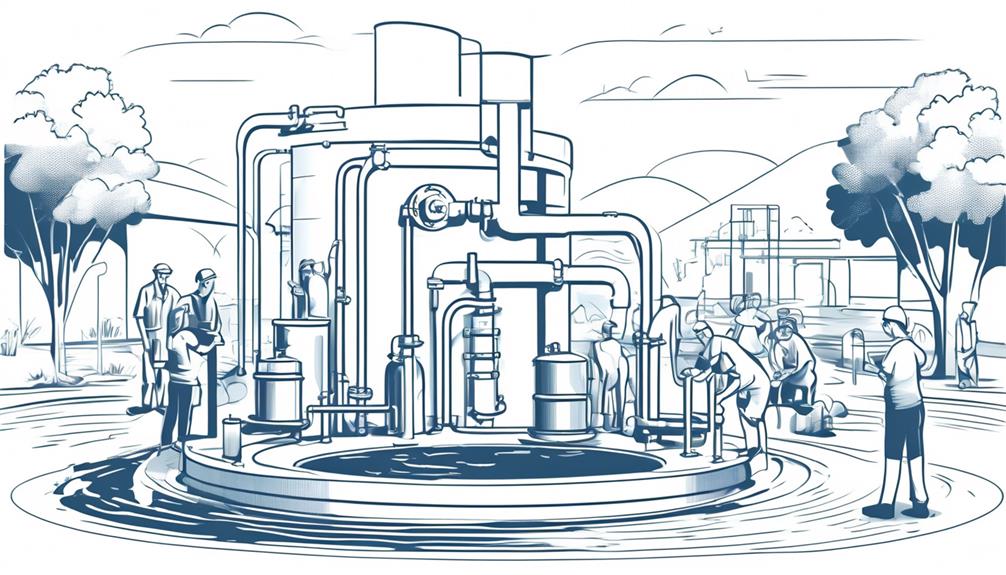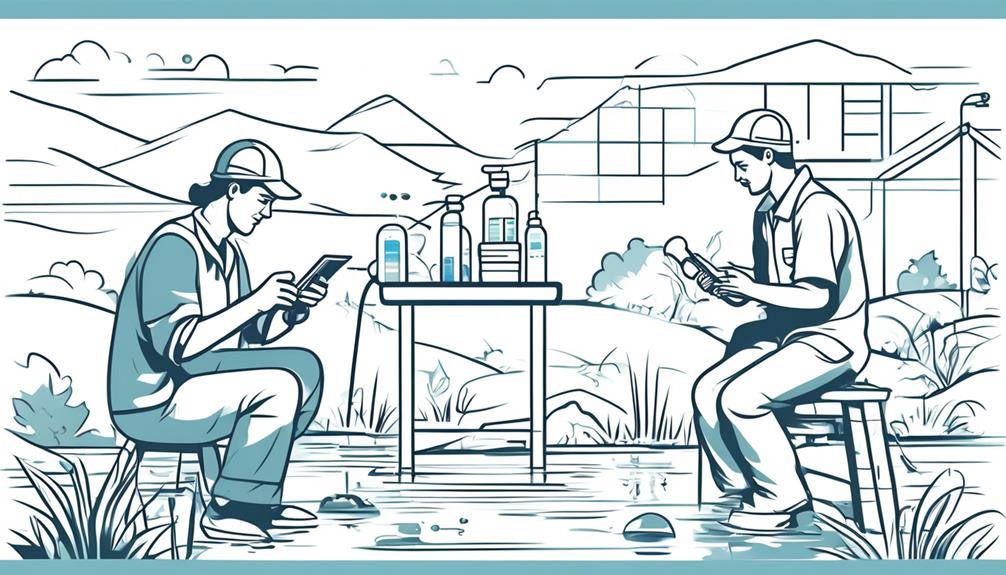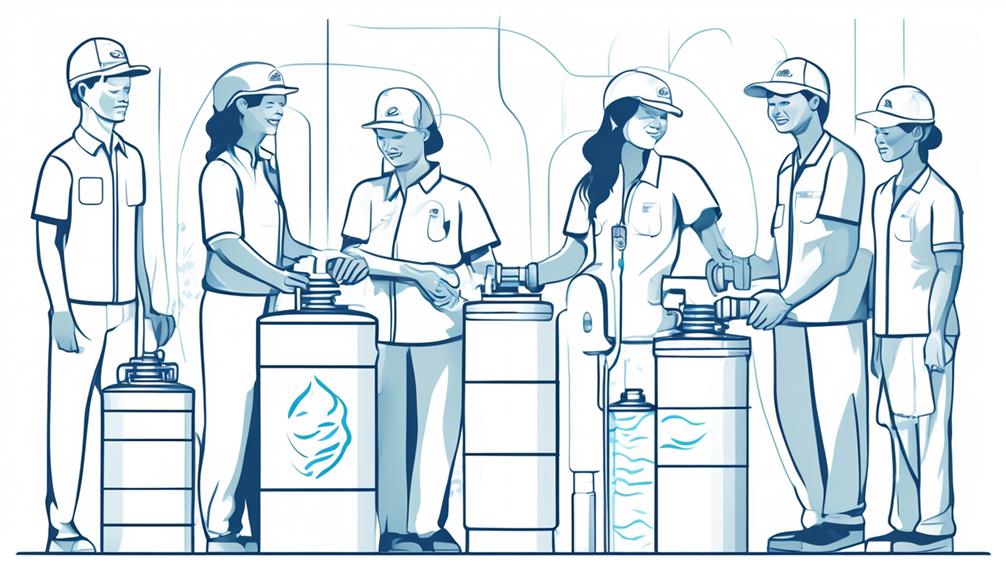Do you know that waterborne diseases are responsible for over 3.4 million deaths each year in developing countries?
With such staggering numbers, it is essential to consider effective measures to combat these illnesses.
From implementing water purification techniques to promoting community health education, several strategies can significantly reduce the prevalence of waterborne diseases.
So, how can these methods be implemented successfully to make a lasting impact on public health in developing nations?
Key Takeaways
- Importance of clean water and sanitation infrastructure development to prevent waterborne diseases
- Community health education and promotion for raising awareness and empowering communities
- Water quality monitoring and management through regular testing and sustainable practices
- Collaboration and partnerships with health authorities for effective disease prevention in developing countries
Importance of Clean Water
Clean water is essential for your health and well-being. Access to clean water is crucial for preventing waterborne diseases that can have serious consequences on your overall health. By ensuring that the water you consume and use for daily activities is free from contaminants, you can protect yourself from illnesses like cholera, typhoid, and diarrhea that are caused by polluted water sources.
Drinking contaminated water can lead to severe dehydration, stomach cramps, and even death in extreme cases. By prioritizing clean water, you're taking a proactive step in safeguarding your health and the health of your community. Simple actions like boiling water before consumption, using water filters, and practicing proper hygiene can make a significant impact on preventing waterborne diseases.
Water Purification Techniques
To ensure the safety of your water supply and protect against waterborne diseases, understanding effective water purification techniques is essential. Boiling water is one of the simplest and most effective ways to kill harmful bacteria and parasites. By bringing water to a rolling boil for at least one minute, you can make it safe to drink.
Another common method is using chlorine or iodine tablets to disinfect water. These tablets are convenient and can kill a wide range of pathogens.
Filtration systems are also crucial for removing impurities. Whether using ceramic filters, activated carbon filters, or reverse osmosis systems, these methods help eliminate contaminants from your water source.
Additionally, ultraviolet (UV) radiation devices can be used to destroy harmful microorganisms. UV light disrupts the DNA of bacteria, viruses, and parasites, rendering them unable to reproduce and cause infections.
Sanitation Infrastructure Development
Hey there!
Let's talk about the key points in sanitation infrastructure development:
ensuring there are enough toilet facilities and promoting access to clean water sources.
These two aspects play a crucial role in preventing waterborne diseases in developing countries.
Let's explore how improving sanitation can make a significant impact on public health.
Adequate Toilet Facilities
Improving access to proper sanitation facilities is crucial for preventing waterborne diseases in developing countries. Adequate toilet facilities play a significant role in maintaining public health. By ensuring that toilets are available and properly constructed, communities can reduce the risk of contamination in water sources.
Encouraging the use of toilets also helps prevent open defecation, which can lead to the spread of diseases. Proper waste disposal through toilets prevents fecal matter from contaminating water supplies, ultimately safeguarding community health.
Governments and organizations should prioritize the construction and maintenance of clean, safe toilets to improve sanitation levels and reduce the incidence of waterborne illnesses. Access to adequate toilet facilities is a fundamental step towards promoting better hygiene practices and preventing the transmission of diseases.
Clean Water Sources
Developing clean water sources through sanitation infrastructure development is essential for preventing waterborne diseases in communities with limited resources. To ensure access to safe drinking water, consider the following:
- Implementing Water Filtration Systems: Installing filters can help remove contaminants and pathogens from water sources.
- Constructing Wells and Boreholes: Digging wells or boreholes provides communities with a reliable source of clean water.
- Establishing Water Treatment Plants: Building treatment facilities can purify water on a larger scale, benefiting entire populations.
Community Health Education
Hey there!
Let's kick off our discussion on Community Health Education by highlighting two crucial points: raising awareness through workshops and promoting good hygiene practices.
These steps are essential in empowering communities to take charge of their health and prevent waterborne diseases effectively.
Awareness Through Workshops
In our workshops on community health education, we emphasize the importance of safe water practices to prevent waterborne diseases.
- Boil It: Always boil water before drinking or using it for cooking to kill harmful pathogens.
- Filter It: Use water filters or strainers to remove impurities and contaminants from drinking water.
- Store It Safely: Store water in clean, covered containers to prevent contamination from insects, dirt, or other sources.
Promote Hygiene Practices
To promote better hygiene practices in your community, start by emphasizing the importance of proper handwashing techniques. Proper handwashing can significantly reduce the spread of waterborne diseases. Encourage everyone to wash their hands with soap and clean water before eating, after using the toilet, and whenever hands are visibly dirty. Additionally, educate your community on the significance of using clean water for daily activities like cooking and drinking. Below is a table summarizing key hygiene practices that can help prevent waterborne diseases:
| Hygiene Practices | Description |
|---|---|
| Handwashing | Wash hands with soap before meals |
| Safe Water Consumption | Use clean water for drinking and cooking |
| Sanitation Facilities | Proper disposal of waste and sewage |
| Personal Hygiene | Bathing regularly and wearing clean clothes |
| Food Safety | Cook food thoroughly and store properly |
Access to Safe Drinking Water

Ensuring access to clean and safe drinking water is crucial in preventing waterborne diseases in developing countries. Without safe water, communities are at a higher risk of contracting illnesses that can have severe consequences on health.
Here are three key strategies to improve access to safe drinking water:
- Investing in Water Treatment Facilities: Building and maintaining water treatment plants can help purify water sources, making them safe for consumption.
- Implementing Water Quality Testing: Regular testing of water sources for contaminants ensures that the water meets safety standards and is suitable for drinking.
- Promoting Community Water Purification Methods: Encouraging the use of simple water purification techniques like boiling, chlorination, or filtration at the community level can significantly reduce waterborne diseases.
Hygiene Promotion Programs
Promoting good hygiene practices among communities is essential in preventing the spread of waterborne diseases in developing countries. Hygiene promotion programs focus on educating individuals about the importance of proper hygiene practices such as handwashing, safe food handling, and sanitation. By raising awareness and providing education, these programs empower communities to take control of their health and well-being.
To visualize the impact of hygiene promotion programs, consider the following table:
| Hygiene Promotion Programs | Benefits |
|---|---|
| Handwashing Campaigns | Reduces spread of diseases |
| Sanitation Workshops | Improves community health |
| Health Education Sessions | Empowers individuals |
| Safe Food Handling Classes | Prevents foodborne illnesses |
Through these programs, individuals learn practical skills that can significantly reduce the risk of waterborne diseases. By actively participating in hygiene promotion initiatives, communities can create a healthier environment for all members.
Regular Water Quality Testing

Regularly testing the quality of water sources is crucial for safeguarding community health against waterborne diseases in developing regions. By implementing routine water quality testing, you can ensure that the water consumed by the community is safe and free from harmful contaminants. Here are three essential reasons why regular water quality testing is vital:
- Early Detection of Contamination: Regular testing allows for the early detection of any contamination in the water sources, enabling prompt action to be taken to prevent the spread of waterborne diseases.
- Monitoring Treatment Effectiveness: Testing water quality regularly helps in monitoring the effectiveness of any water treatment methods being used, ensuring that the water purification processes are functioning correctly.
- Compliance with Standards: Regular testing helps communities to ensure that their water sources meet the required health and safety standards, promoting overall well-being and preventing the outbreak of waterborne illnesses.
Sustainable Water Management
Developing sustainable water management practices is essential for ensuring long-term access to safe and clean water sources in communities worldwide. By implementing strategies like rainwater harvesting, greywater recycling, and watershed protection, communities can secure water availability for future generations.
Rainwater harvesting involves collecting rainwater from rooftops or other surfaces and storing it for later use, reducing reliance on dwindling groundwater sources. Greywater recycling treats water from sinks, showers, and laundry for reuse in irrigation or toilet flushing, conserving precious freshwater resources. Watershed protection focuses on preserving the natural areas that feed into rivers and lakes, safeguarding water quality by preventing pollution and erosion.
Engaging in sustainable water management not only benefits the environment but also promotes community health and resilience. By taking proactive steps to manage water resources responsibly, you can help ensure a reliable and sustainable water supply for your community's present and future needs. Remember, small actions today can lead to significant improvements in water security tomorrow.
Collaboration With Health Authorities

For effective prevention of waterborne diseases in developing countries, establishing strong partnerships with health authorities is crucial. By collaborating with health authorities, you can ensure a more coordinated and effective approach to combating waterborne diseases. Here are three key ways this collaboration can make a significant impact:
- Data Sharing: Working closely with health authorities allows for the sharing of essential data on water quality, disease outbreaks, and at-risk populations. This information exchange enables better decision-making and targeted interventions.
- Resource Allocation: Partnering with health authorities helps in aligning resources efficiently. By pooling together expertise and resources, you can maximize the impact of prevention efforts and reach more communities in need.
- Capacity Building: Collaborating with health authorities provides opportunities for training and capacity-building initiatives. This can empower local healthcare workers and communities with the knowledge and skills needed to address waterborne diseases effectively.
Engaging in strong partnerships with health authorities is a proactive step towards safeguarding public health and reducing the burden of waterborne illnesses in developing countries.
Disaster Preparedness Planning
Alright, let's talk about disaster preparedness planning.
You need to consider risk assessment strategies, emergency response protocols, and resource allocation planning.
These points are crucial for effectively managing waterborne disease outbreaks during emergencies.
Risk Assessment Strategies
To effectively prepare for disasters, it's crucial to assess potential risks and develop comprehensive strategies for mitigating them. When it comes to risk assessment strategies for disaster preparedness planning in developing countries, consider the following:
- Conduct thorough vulnerability assessments in communities to identify potential hazards.
- Engage with local stakeholders to understand their perspectives and gather valuable insights.
- Establish early warning systems and emergency response protocols to minimize the impact of disasters.
Emergency Response Protocols
Having understood the importance of risk assessment strategies in disaster preparedness planning for developing countries, the focus now shifts towards establishing effective emergency response protocols.
In times of crisis, quick and coordinated actions can save lives. Developing countries often face challenges in responding to emergencies due to limited resources and infrastructure.
It's crucial to create detailed emergency plans that outline roles, responsibilities, and communication channels. Training local communities in first aid, evacuation procedures, and water purification methods can also enhance preparedness.
Regular drills and simulations help identify gaps in the response system and allow for necessary adjustments. Collaborating with local authorities, NGOs, and international organizations can further strengthen emergency response capabilities and ensure a more coordinated effort during disasters.
Resource Allocation Planning
In disaster preparedness planning, effective resource allocation is essential for ensuring timely and efficient response to emergencies in developing countries.
When it comes to resource allocation planning, consider the following:
- Prioritize Essential Supplies: Ensure that critical resources such as clean water, medical supplies, and food are readily available in emergency situations.
- Establish Communication Channels: Set up reliable communication systems to coordinate resource distribution and provide updates during crises.
- Train Local Personnel: Invest in training programs for local staff to enhance their capacity in managing resources effectively and responding promptly to disasters.
Frequently Asked Questions
How Do Waterborne Diseases Impact the Overall Health and Well-Being of Communities in Developing Countries?
Waterborne diseases devastate communities in developing countries, affecting health and well-being. You must prioritize clean water access, sanitation, and hygiene practices to combat these illnesses. Prevention is key to safeguarding the health of all.
What Are the Main Challenges Faced in Implementing Sustainable Water Management Practices in Developing Countries?
To implement sustainable water management practices in developing countries, you must address challenges like inadequate infrastructure, lack of resources, and limited access to clean water. By investing in education, technology, and community involvement, progress can be made.
How Can Community Health Education Programs Be Tailored to Effectively Address Waterborne Diseases in Different Cultural Contexts?
To effectively address waterborne diseases in different cultural contexts, tailor community health education programs. Engage, educate, empower. Teach hygiene practices, water treatment methods. Involve local leaders, use interactive tools. Make learning fun, relevant. Together, we can prevent illnesses and promote well-being.
What Role Do Local Health Authorities Play in Collaborating With Organizations to Prevent Waterborne Diseases in Developing Countries?
Local health authorities play a pivotal role in collaborating with organizations to prevent waterborne diseases in developing countries. Their proactive measures, prompt interventions, and partnerships are crucial in safeguarding communities from water-related health threats.
How Can Disaster Preparedness Planning Specifically Address the Risk of Waterborne Diseases During Emergencies in Developing Countries?
During emergencies in developing countries, disaster preparedness planning can specifically address waterborne disease risks by ensuring access to clean water sources, promoting hygiene practices, and providing quick medical response to prevent the spread of illnesses.
Conclusion
You now have the tools to make a real difference in preventing waterborne diseases in developing countries.
By implementing water purification techniques, improving sanitation infrastructure, educating communities, ensuring access to safe drinking water, testing water quality regularly, managing water sustainably, collaborating with health authorities, and planning for disasters, you can help save lives and improve the health of countless individuals.
Take action today and be a part of the solution to this critical issue.
Together, we can make a positive impact on the world.